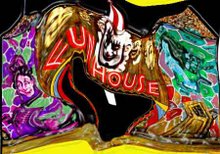The Archaeological Site at Beit She'an Part 1
This site is the most amazing thing I have seen in Israel., so I took a lot of pictures and will divide this post into two parts. It is a national park and the ruins are everywhere. There are so many buildings and remnants of so many cultures.
Because it lies at the junction of the Jezreel and Jordan valleys, this site has been inhabited since the early Bronze Age (3200 BCE). It was an Egyptian administrative center in the 15th Century BCE and the Egyptians inhabited the area for more than 300 years. They discovered a stela here that they called "The Lion and Dog Stela:
(I tried to link this, but the link misbehaved - it is from the Account of the Excavations by Hebrew University : http://www.rehov.org/project/tel_beth_shean.htm#Egyptian)
They believe that the Sea People invaded and toppled Egyptian rule and the were replaced by the Canaanites, before they were conquered by the Philistines in 1100 BCE. King David retook the area which was then also later ruled by Solomon. The Assyrians then conquered it (732 BCE) and set it on fire.
During the Hellenic period, the Greeks named it Scythopolis (named for Sythian mercenaries) and a temple was built on top of the hill (Tel). More wars (Ptolemies versus Syrians) and more fire by the end of the second century BCE.
The Romans rebuilt the city calling it Decapolis and we looked at the primary Roman ruins during our field trip. We drove by the hippodrome on the way to the park.
When one first enters the park, one is struck by the numerous rows of columns.
Below you can see the block of stone with the wheels on either side that show how the Romans (and Greeks) got their building blocks to the scene.
This is a better shot of the device:
Here is a kind of panorama view . There are baths on the left a street with shops and a colonnade in the middle and the amphitheatre is the huge dark building on the right.
Here are the cornices that were on the amphitheater.
We started off at the amphitheater - (The best preserved one in Samaria)
It is beautiful. It would have had large statues in the niches on the stage area and supposedly the pillars were even taller.
This is the right side of the stage area.
Up on the top you have a great view of some of the other features. Below you can see the main colonnade along the street where there were all kinds of shops.
This is a better view of the street - which you can see slopes from the middle down to the right in order to enhance drainage. (The Romans knew just about everything there is to know about handling water.)
This is farther down to the right of the main street where there was a temple.
This is a view from the amphitheater towards the baths and latrines. (more to the left).
I'll do a second post on the baths and latrines and what you see behind the main plaza.

















No comments:
Post a Comment